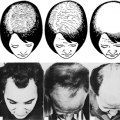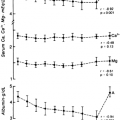THYROID CANCER
Carcinoma of the thyroid gland in pediatric patients is rare.33 Its incidence has increased since 1951, when Winship was able to find 93 cases in the world’s literature, to which he added 99 cases in 1970.34 Since 1970, the incidence may be decreasing.
ETIOLOGY
There is a significant association between thyroid carcinoma in children and adolescents and irradiation to the head and neck (see Chap. 39 and Chap. 40). Also, there is some evidence that an increased serum TSH level may be implicated in thyroid cancer. Several retrospective studies have indicated that the recurrence of cancer can be minimized and survival improved with thyroid hormone therapy. Differentiated thyroid cancers have TSH receptors, and in vitro these tumors respond metabolically to TSH stimulation.
PATHOLOGY
All of the histologic types of thyroid cancer that occur in adults are found in children and adolescents but, fortunately, with a slightly higher proportion of differentiated carcinomas. Papillary adenocarcinoma is the most common histologic type. Papillary cancers often contain follicular elements and may be designated mixed papillary and follicular carcinomas. Papillary carcinomas spread to the normal surrounding thyroid parenchyma and regional lymph nodes as they invade lymphatics. These carcinomas characteristically grow slowly. Follicular carcinomas have a marked tendency for vascular invasion and spread to bone and lung. Medullary thyroid cancer arises from the C cells of the thyroid and secretes calcitonin and other substances. Early spread is typically through the lymphatics. Undifferentiated carcinoma (anaplastic) is uncommon in children and causes early death because of extensive local and disseminated disease (see Chap. 40).
Stay updated, free articles. Join our Telegram channel

Full access? Get Clinical Tree





